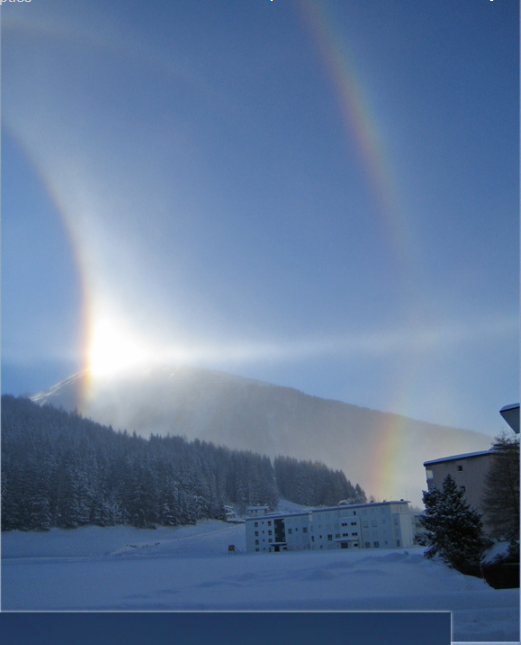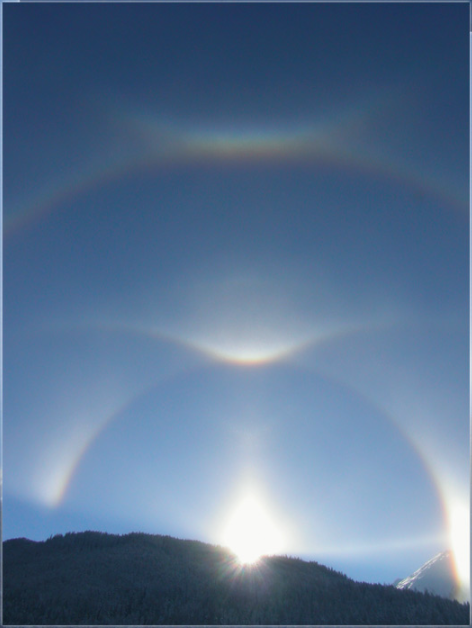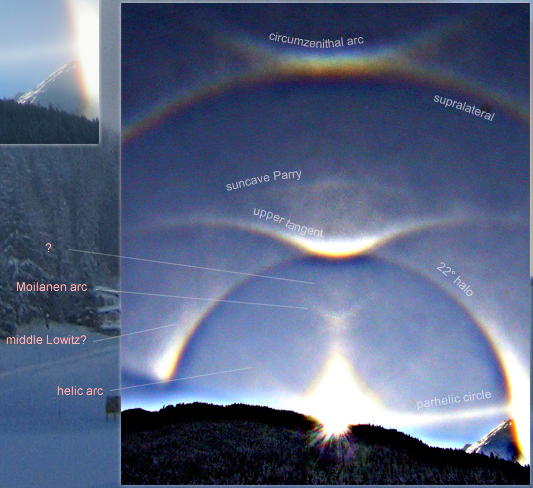Swiss Rarities
Swiss Rarities: Exploring Rare Atmospheric Optics in Davos, Switzerland
Davos, Switzerland is renowned for its breathtaking natural beauty and the unique atmospheric optics phenomena that can be observed in this region. While diamond dust ice crystal displays, parhelia (sundogs), and 22-degree halos are common sights, it is the rarer halos that truly captivate the attention of observers.
One of the most intriguing phenomena in Davos is the presence of horizontal column crystals that generate supralateral and infralateral arcs. These arcs exhibit pure and widely separated colors, crossing the parhelic circle to form a distinctive cusp shape. The sharp colors and unique formation make it clear that these arcs are not the commonly seen 46-degree halo.
In addition to the supralateral and infralateral arcs, there are two particularly rare arcs that can occasionally be observed. The top image hints at the possibility of a Parry supralateral (Tape arc), which is formed by Parry oriented columns. This arc is characterized by a brightening at 2 o'clock on the supralateral arc. Another potential rare arc is the middle Lowitz arc, which curves upwards from the sundog. These elusive arcs add to the allure of Davos' atmospheric optics.
The lower image provides further insights into the unique atmospheric phenomena in Davos. Through an unsharp mask enhancement, helic arcs formed by external sunlight reflections off the side faces of Parry crystals can be observed. These helic arcs contribute to the intricate and mesmerizing display of rare atmospheric optics in Davos.
Among the rarities witnessed in Davos is a phenomenon known as the Moilanen arc. Despite extensive research, the origin and formation of this halo remain a mystery. However, its distinct appearance adds to the enigmatic nature of atmospheric optics in this region. Furthermore, there is a suggestion of another halo above the Moilanen arc, potentially produced by the same crystals that generated the latter. This interplay of different atmospheric phenomena creates a captivating visual spectacle.
Davos, Switzerland continues to be a haven for atmospheric optics enthusiasts and researchers alike. The unique combination of diamond dust ice crystals, parhelia, and halos, both common and rare, make this region an ideal location for studying and appreciating the wonders of the atmosphere. The constant discovery of new and unexplained phenomena keeps scientists and observers in awe, further fueling their curiosity to unravel the secrets of the sky.
In conclusion, Davos, Switzerland offers a wealth of rare atmospheric optics phenomena for those lucky enough to witness them. The supralateral and infralateral arcs, the possibility of Parry supralateral and middle Lowitz arcs, the helic arcs formed by external sunlight reflections, and the mysterious Moilanen arc all contribute to the allure of this region. Exploring these rarities not only provides visual delight but also presents an opportunity to delve deeper into the mysteries of our atmosphere. Davos truly is a treasure trove for atmospheric optics enthusiasts and researchers seeking to expand our understanding of the world above us.

Davos, Switzerland Rare Halos
Top image by Barbara Landl, lower image Christian Rixen. Images ©The photographers, shown with permission.


A diamond dust ice crystal display dominated by a dazzling parhelion (sundog), white parhelic circle and 22-degree halo.
It is, however, the fainter halos that demand attention.
Horizontal column crystals generated supralateral and infralateral arcs with their characteristically pure and widely separated colours. They cross the parhelic circle to form a cusp shape � a sure indication, if the sharp colours did not already tell us, that the arcs are not a 46-degree halo.
The top picture hints at two rarer arcs. The brightening at 2 o�clock on the supralateral arc �might� be a trace of a Parry supralateral (Tape arc) formed by Parry oriented columns. Curving upwards from the sundog is another rare arc possibility � a middle Lowitz arc.
The lower image and its unsharp mask enhancement show helic arcs formed by external sunlight reflections off the side faces of Parry crystals.
There is also a definite Moilanen arc, a halo form yet to be explained. The hint of a halo above the Moilanen arc might be produced by the same crystals that generated the latter.
Note: this article has been automatically converted from the old site and may not appear as intended. You can find the original article here.
Reference Atmospheric Optics
If you use any of the definitions, information, or data presented on Atmospheric Optics, please copy the link or reference below to properly credit us as the reference source. Thank you!
-
<a href="https://atoptics.co.uk/blog/swiss-rarities/">Swiss Rarities</a>
-
"Swiss Rarities". Atmospheric Optics. Accessed on November 14, 2024. https://atoptics.co.uk/blog/swiss-rarities/.
-
"Swiss Rarities". Atmospheric Optics, https://atoptics.co.uk/blog/swiss-rarities/. Accessed 14 November, 2024
-
Swiss Rarities. Atmospheric Optics. Retrieved from https://atoptics.co.uk/blog/swiss-rarities/.